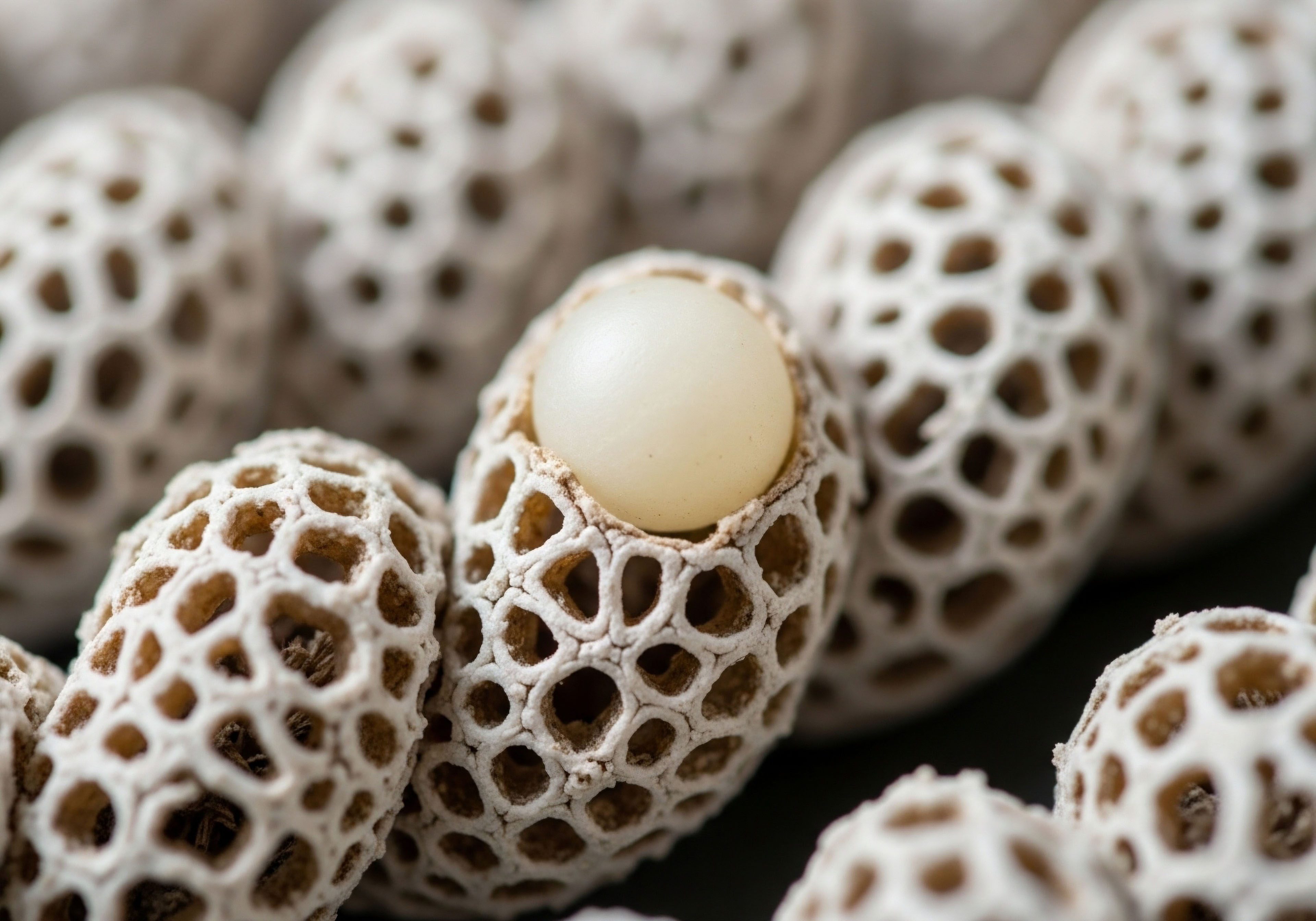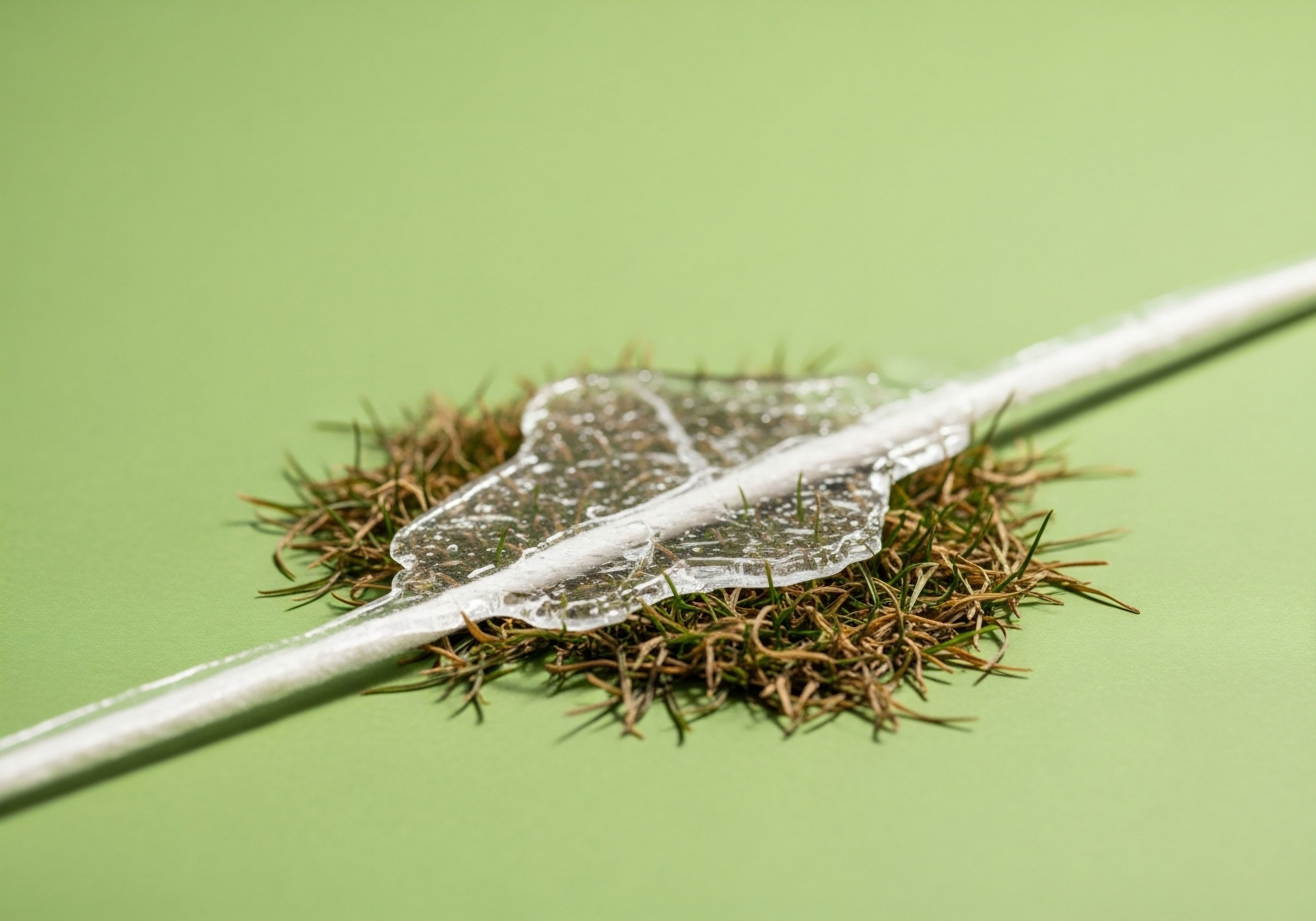

Fundamentals
Experiencing changes in your hair can feel deeply unsettling. Perhaps you notice more strands collecting in your brush, a widening part, or a general reduction in volume that was once a source of confidence. These shifts often prompt a quiet concern, a sense that something within your body is no longer operating as it should.
This personal observation is often the first indication of a deeper biological conversation occurring within your endocrine system. Understanding these internal signals, particularly those related to hormonal balance, becomes a vital step in reclaiming your vitality and overall well-being.
The intricate network of hormones acts as your body’s internal messaging service, orchestrating countless physiological processes, including the growth and health of your hair. When these messengers are out of sync, the effects can manifest in various ways, and hair thinning or loss is a common, visible symptom.
It is a signal that warrants attention, not merely a cosmetic issue. For many women, these changes coincide with significant life stages, such as perimenopause or postmenopause, where hormonal fluctuations become more pronounced.
Hair changes often signal deeper hormonal shifts, prompting a need for biological understanding.
Testosterone, often perceived as a primary male hormone, plays a significant and often underestimated role in female physiology. Women produce testosterone in their ovaries and adrenal glands, and it contributes to bone density, muscle mass, mood regulation, and libido. The concept of introducing exogenous testosterone, such as through pellet therapy, for women experiencing symptoms of androgen deficiency has gained recognition.
However, questions frequently arise regarding its long-term impact, especially on hair health. The relationship between testosterone and hair follicles in women is complex, involving various enzymes and receptors that can influence hair growth cycles.

The Endocrine System and Hair Follicle Dynamics
Hair follicles are highly sensitive structures, responding to a symphony of hormonal cues. Each follicle undergoes a cyclical process of growth (anagen), regression (catagen), and rest (telogen). The duration and health of these phases are heavily influenced by circulating hormones. When hormonal levels are disrupted, this delicate cycle can falter, leading to changes in hair density and texture.
Androgens, a class of hormones that includes testosterone, are known to influence hair growth. In certain contexts, particularly in genetically predisposed individuals, higher levels of androgens or increased sensitivity of hair follicles to these hormones can lead to follicular miniaturization. This process involves the gradual shrinking of hair follicles, resulting in the production of finer, shorter, and less pigmented hair strands over time. Ultimately, these follicles may cease producing visible hair.

Understanding Androgen Sensitivity
The impact of androgens on hair is not uniform across the body. While androgens promote hair growth in areas like the armpits and pubic region, they can paradoxically contribute to hair thinning on the scalp in susceptible individuals. This differential response is attributed to the varying distribution and activity of enzymes and androgen receptors within hair follicles in different body regions.
The enzyme 5-alpha reductase, for instance, converts testosterone into a more potent androgen, dihydrotestosterone (DHT). Follicles on the scalp that are sensitive to DHT may undergo miniaturization, while those elsewhere may be stimulated.
For women considering testosterone pellet therapy, understanding this nuanced relationship is paramount. The goal of such therapy is to restore optimal hormonal balance, alleviating symptoms of androgen deficiency. The potential effects on hair health, whether beneficial or adverse, depend on individual biological responses, genetic predispositions, and the precise management of hormone levels. It is a personalized journey, requiring careful consideration of one’s unique biological blueprint.


Intermediate
When considering hormonal optimization protocols, particularly testosterone pellet therapy for women, a detailed understanding of the clinical approach becomes essential. This therapy involves the subcutaneous insertion of small, custom-compounded pellets that release a steady, low dose of testosterone over several months. The aim is to maintain consistent physiological levels, avoiding the peaks and troughs associated with other administration methods. This consistent delivery is designed to support various bodily systems, from metabolic function to cognitive clarity.
The rationale for using testosterone in women stems from its role in maintaining overall well-being. Women experiencing symptoms such as persistent fatigue, reduced libido, mood changes, or difficulty maintaining muscle mass, even with adequate estrogen and progesterone, may benefit from targeted androgen support. The protocols for female testosterone replacement therapy are distinct from those for men, emphasizing lower dosages to align with female physiological requirements.
Testosterone pellet therapy offers consistent hormone delivery, aiming to restore female physiological balance.

Testosterone Pellet Therapy Protocols for Women
For women, testosterone replacement therapy often involves subcutaneous injections of Testosterone Cypionate, typically administered weekly in small doses, ranging from 0.1 to 0.2 milliliters. Alternatively, pellet therapy provides a long-acting option. These pellets are inserted under the skin, usually in the hip or buttock area, and slowly dissolve, releasing testosterone. The dosage and frequency of pellet insertion are highly individualized, determined by a woman’s symptoms, laboratory values, and clinical response.
A key consideration in female hormonal optimization is the interplay between testosterone and other sex hormones. For instance, progesterone is often prescribed alongside testosterone, particularly for peri-menopausal and post-menopausal women, to ensure comprehensive hormonal balance and protect uterine health.
In some cases, an aromatase inhibitor, such as Anastrozole, may be considered if there is a tendency for testosterone to convert excessively into estrogen, although this is less common in women receiving physiological doses compared to men on higher therapeutic regimens.

Addressing Hair Health within Protocols
The long-term effects of testosterone pellet therapy on female hair health are a significant concern for many individuals. Clinical observations and some research indicate that testosterone therapy, when appropriately dosed for women with androgen deficiency, can actually improve scalp hair growth. This suggests an anabolic, or building, effect of testosterone on hair follicles in certain individuals.
However, the complexity arises from the potential for testosterone to convert into dihydrotestosterone (DHT), a more potent androgen that can contribute to hair thinning in genetically susceptible individuals.
The balance of enzymes within the hair follicle, particularly 5-alpha reductase and aromatase, plays a critical role. Aromatase converts androgens into estrogens, which are generally considered beneficial for female hair health. Women naturally have higher aromatase activity in their frontal hair follicles compared to men, which may offer some protection against androgen-induced hair loss.
When evaluating hair changes during testosterone therapy, it is crucial to consider the overall hormonal environment and other contributing factors. These may include ∞
- Thyroid function ∞ Both underactive and overactive thyroid conditions can lead to hair loss.
- Nutritional status ∞ Deficiencies in iron, zinc, or specific vitamins can impact hair health.
- Stress levels ∞ Chronic stress can disrupt the hair growth cycle, leading to increased shedding.
- Genetic predisposition ∞ Individual sensitivity to androgens varies significantly.
- Medications ∞ Certain drugs, including some oral contraceptives or medications for other conditions, can influence hair growth.
A comprehensive assessment involves not only monitoring testosterone levels but also evaluating other hormones, such as Sex Hormone Binding Globulin (SHBG). SHBG binds to sex hormones, including testosterone, making them inactive. Lower SHBG levels mean more free, biologically active testosterone is available, which could, in some cases, increase the likelihood of androgenic effects on hair if the individual is sensitive.
| Hormone/Factor | Typical Impact on Hair | Relevance to Testosterone Therapy |
|---|---|---|
| Testosterone | Can improve scalp hair growth in androgen-deficient women; potential for thinning if converted to DHT in susceptible individuals. | Therapeutic goal is balance; individual response to conversion is key. |
| Dihydrotestosterone (DHT) | Primary androgen linked to follicular miniaturization and pattern hair loss. | Conversion from testosterone is a consideration; genetic sensitivity matters. |
| Estrogen | Generally protective and extends hair growth phase. | Balance with androgens is important; aromatase inhibitors can lower estrogen. |
| Sex Hormone Binding Globulin (SHBG) | Binds hormones, reducing their activity; low levels mean more free hormones. | Monitoring SHBG helps assess biologically active testosterone levels. |
| Thyroid Hormones | Essential for hair growth cycle; imbalance causes thinning or loss. | Always evaluated alongside sex hormones for comprehensive care. |
The clinical decision-making process for female testosterone therapy and its potential impact on hair involves a careful titration of dosage, ongoing monitoring of symptoms and laboratory markers, and a holistic assessment of the individual’s overall health. It is a dynamic process, adjusting protocols to achieve optimal outcomes while mitigating any undesirable effects.


Academic
The long-term effects of testosterone pellet therapy on female hair health necessitate a deep dive into the underlying endocrinological mechanisms and the complex interplay of biological axes. While clinical experience and some studies suggest a beneficial effect of testosterone on scalp hair in androgen-deficient women, the potential for androgen-induced alopecia remains a topic of rigorous scientific inquiry. This apparent paradox underscores the intricate nature of hormonal signaling within the pilosebaceous unit.
The prevailing understanding of androgenetic alopecia, whether in males or females, centers on the role of dihydrotestosterone (DHT). DHT, a potent metabolite of testosterone, exerts its effects by binding to androgen receptors within susceptible hair follicles, particularly those on the scalp.
This binding initiates a cascade of events that leads to follicular miniaturization, a process where terminal hairs gradually transform into vellus hairs, becoming progressively finer and shorter. The enzyme 5-alpha reductase, specifically its type I and type II isoforms, catalyzes the conversion of testosterone to DHT.
Hair follicle response to testosterone is a complex interplay of androgen metabolism and receptor sensitivity.

Androgen Metabolism and Follicular Sensitivity
In women, the dynamics of androgen metabolism within the hair follicle differ significantly from men. Female frontal hair follicles possess lower levels of 5-alpha reductase isoforms compared to male follicles. Conversely, women exhibit substantially higher levels of aromatase, an enzyme that converts androgens, including testosterone, into estrogens (e.g.
17β-estradiol). This higher aromatase activity in female scalp follicles is hypothesized to provide a protective mechanism against androgen-induced miniaturization, as estrogens are generally considered hair-protective and extend the anagen (growth) phase of the hair cycle.
When exogenous testosterone is introduced via pellet therapy, the systemic testosterone levels increase. The subsequent impact on hair health depends on the balance between its direct anabolic effects on hair follicles and its conversion to DHT, modulated by individual variations in 5-alpha reductase activity and aromatase expression.
Some studies indicate that even with therapeutic serum testosterone levels, scalp hair loss is not a commonly reported adverse effect, and in many cases, women experiencing hair thinning prior to therapy report hair regrowth. This suggests that the anabolic properties of testosterone, or perhaps a rebalancing of the overall hormonal milieu, can outweigh the potential for DHT-mediated miniaturization in a clinical setting.

The Role of Sex Hormone Binding Globulin
The bioavailability of testosterone is also a critical factor. Circulating testosterone exists in three forms ∞ bound to Sex Hormone Binding Globulin (SHBG), bound loosely to albumin, and as free, unbound testosterone. Only the free and albumin-bound fractions are considered biologically active. SHBG has a high affinity for testosterone and DHT, effectively sequestering these hormones and rendering them inactive.
Variations in SHBG levels can profoundly influence the amount of biologically active testosterone available to hair follicles. Conditions that lower SHBG, such as insulin resistance, obesity, or hypothyroidism, can lead to an increase in free testosterone, even if total testosterone levels appear normal.
This increase in free testosterone, and its subsequent conversion to DHT, could potentially exacerbate androgenic effects on hair in susceptible individuals. Therefore, a comprehensive assessment of female hormonal health must include SHBG levels to accurately interpret androgen status and predict potential hair responses to therapy.
Consider the following table illustrating the enzymatic pathways influencing androgen action in hair follicles ∞
| Enzyme | Location/Function | Impact on Hair Follicle |
|---|---|---|
| 5-alpha Reductase (Type I & II) | Hair follicles, skin, prostate; converts testosterone to DHT. | High activity leads to increased DHT, promoting miniaturization in susceptible follicles. |
| Aromatase | Hair follicles, adipose tissue, ovaries; converts androgens to estrogens. | High activity leads to increased estrogen, generally protective for hair growth. |
| Androgen Receptor (AR) | Within hair follicle cells; binds testosterone and DHT. | Sensitivity and number of receptors determine response to androgens. |

Systemic Influences and Therapeutic Considerations
Beyond direct androgen action, the broader metabolic and inflammatory landscape significantly impacts hair health. Conditions like Polycystic Ovary Syndrome (PCOS), characterized by insulin resistance and elevated androgens, frequently present with hair thinning on the scalp alongside hirsutism (excess body hair). This connection suggests that systemic metabolic dysregulation can influence follicular sensitivity and androgen metabolism.
The long-term management of female hair health in the context of testosterone pellet therapy requires a dynamic, personalized approach. If hair thinning occurs or worsens, a thorough investigation into contributing factors is warranted. This includes re-evaluating testosterone dosage, assessing SHBG and other hormone levels, screening for thyroid dysfunction, nutritional deficiencies, and systemic inflammation.
Therapeutic strategies to mitigate potential androgenic effects on hair, while maintaining the benefits of testosterone, may involve ∞
- Dosage Adjustment ∞ Reducing the testosterone dose to find the lowest effective level that alleviates symptoms while minimizing androgenic side effects.
- Topical Treatments ∞ Utilizing topical agents like minoxidil, which promotes hair growth by increasing blood flow to follicles and extending the anagen phase.
- Anti-Androgens ∞ In select cases, medications such as spironolactone may be considered. Spironolactone acts by blocking androgen receptors and reducing androgen production, and has shown efficacy in treating female pattern hair loss.
- Peptide Therapy ∞ Emerging research explores the use of specific peptides, such as GHK-Cu (Copper Peptides), which may stimulate hair follicles, reduce inflammation, and inhibit 5-alpha reductase activity, potentially offering a supportive role in hair health.
- Addressing Underlying Conditions ∞ Managing insulin resistance, thyroid disorders, or chronic stress can significantly improve overall hormonal balance and, consequently, hair health.
The evidence base for testosterone pellet therapy in women, particularly concerning long-term hair effects, continues to grow. While some studies suggest a positive impact on scalp hair, individual variability and the complex interplay of hormones, genetics, and systemic health factors mean that a one-size-fits-all approach is insufficient. The most effective strategy involves careful clinical oversight, continuous monitoring, and a willingness to adjust protocols based on the individual’s unique biological response and health goals.

References
- Glaser, Rebecca L. and Constantine Dimitrakakis. “Improvement in scalp hair growth in androgen-deficient women treated with testosterone ∞ a questionnaire study.” British Journal of Dermatology, vol. 166, no. 2, 2012, pp. 274-278.
- Glaser, Rebecca L. and Constantine Dimitrakakis. “Testosterone therapy in Women ∞ Myths and misconceptions.” Maturitas, vol. 74, 2013, pp. 230-234.
- Herskovitz, Adam M. and Antonella Tosti. “Female pattern hair loss ∞ A clinical, pathophysiologic, and therapeutic review.” Journal of the American Academy of Dermatology, vol. 78, no. 5, 2018, pp. 1015-1025.
- Miller, J. A. et al. “Low sex-hormone binding globulin levels in young women with diffuse hair loss.” British Journal of Dermatology, vol. 106, no. 3, 1982, pp. 331-336.
- Pyo, H. K. et al. “The effect of copper peptide on the proliferation and differentiation of hair follicle cells.” Journal of Cosmetic Science, vol. 58, no. 4, 2007, pp. 385-392.
- Sinclair, Rodney. “Female pattern hair loss ∞ a clinical, pathophysiologic, and therapeutic review.” Journal of the American Academy of Dermatology, vol. 78, no. 5, 2018, pp. 1015-1025.
- Varothai, S. and W. F. Bergfeld. “Female pattern hair loss ∞ an overview of the etiology, diagnosis and management.” International Journal of Women’s Dermatology, vol. 1, no. 1, 2015, pp. 12-19.
- Yip, L. et al. “The role of androgens in female pattern hair loss.” Indian Journal of Dermatology, Venereology, and Leprology, vol. 79, no. 5, 2013, pp. 629-637.

Reflection
Your personal health journey is a dynamic process, not a static destination. The insights gained regarding hormonal health and its intricate connection to hair vitality serve as a foundation, inviting you to consider your own biological systems with renewed understanding. This knowledge empowers you to engage in more informed conversations with your healthcare providers, advocating for a personalized path that truly aligns with your unique needs and aspirations for well-term well-being.
The information presented here is a guide, a map to help you navigate the complexities of your internal landscape. It encourages introspection, prompting you to ask deeper questions about your symptoms and how they relate to the broader symphony of your body’s functions. Reclaiming vitality and function without compromise begins with this self-awareness, leading to choices that support your biological systems in their entirety.

Glossary

hormonal balance

hair thinning

pellet therapy

influence hair growth

hair health

dihydrotestosterone

5-alpha reductase

testosterone pellet therapy

hormonal optimization

metabolic function

improve scalp hair growth

testosterone therapy

female hair health

aromatase activity

hair loss

hormone binding globulin

levels mean more free

androgen metabolism

testosterone levels

biologically active testosterone available

polycystic ovary syndrome

female pattern hair loss




